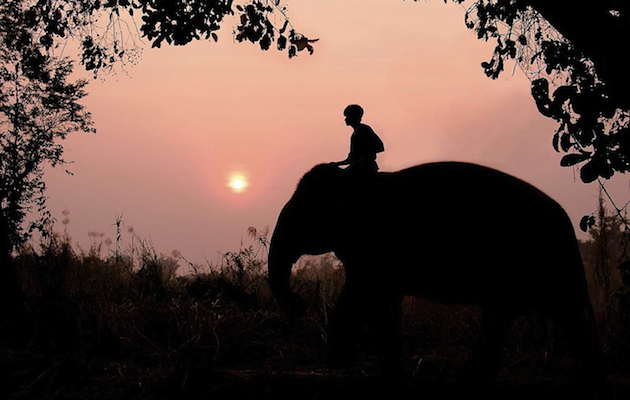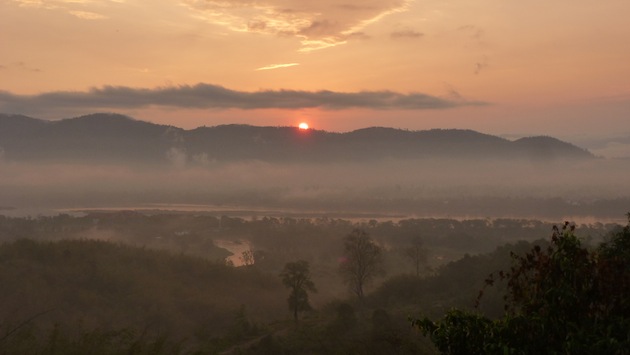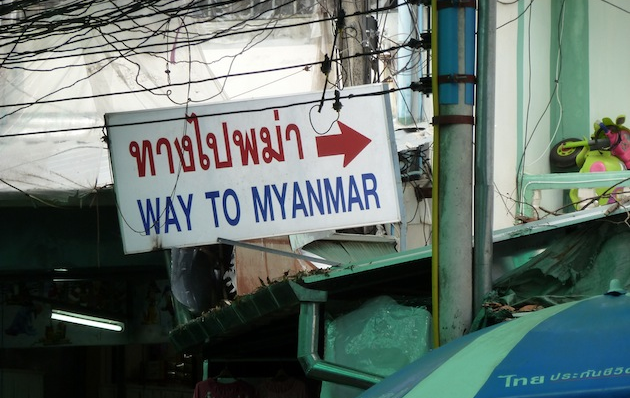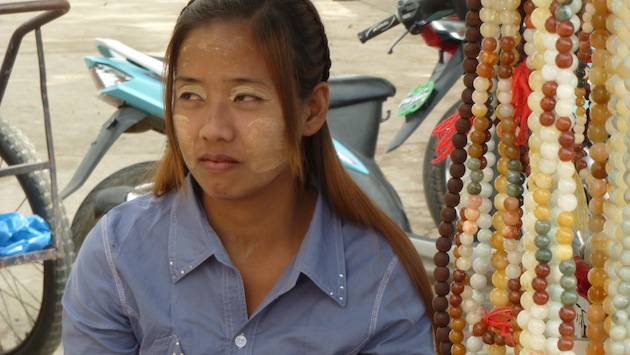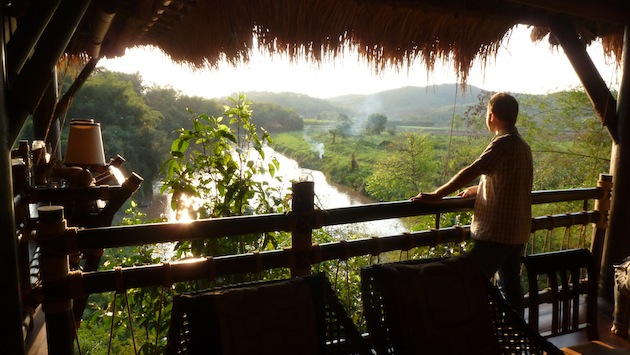The next morning Thong Kam was about as pleased to see me as I was prepared to ride her. I apologised for getting her up at this hour and, as if the alarm wasn’t bad enough, humans aren’t really designed to mount an elephant at 5am. I was, needless to say, the only one mad enough to do this and the poor old girl grunted her displeasure as she inched her way reluctantly up the hill behind the camp through the woods in the blue light of the dawn. Fortunately we were accompanied by Paul, our talkative guide, but she made no secret of her disdain for being roused when she let out an extraordinary grumble which was in turn answered by Boon Ma, her best friend, who let out a sympathetic bellow from their distant bedside which seemed to reverberate around the valley.
The purpose of this particular exercise became clear when we stopped at the top of the hill, the highest point of the camp, and with coffee and croissants for sustenance we took in the scene: before us, and surrounding us, was the most beautiful, ethereal vision of misty treetops, hills and valleys and the rivers that joined them. And then, on cue, the sun broached the mountain ahead of us, speeding up this changing scenery and completing the picture with its soft amber halo. It was worth it for anything. Thong Kam seemed to enthuse, too, though I suspect more because it signalled our descent back 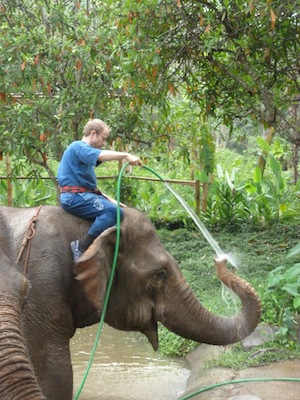 to camp. And on this occasion it was her turn for a shower, and one which I obliged her with. Hosing her down, knelt on her back, she flapped her ears in gratitude, raising her trunk to me in pleasure and in a gesture of affection. It seems Thong Kam and I had bonded.
to camp. And on this occasion it was her turn for a shower, and one which I obliged her with. Hosing her down, knelt on her back, she flapped her ears in gratitude, raising her trunk to me in pleasure and in a gesture of affection. It seems Thong Kam and I had bonded.
That afternoon one of the other highlights of this corner of the country lay in store, though technically not in the country. After lunch, I was met by Paul again, not in his mahout fatigues but this time in his tour guide khaki, and we boarded a people carrier for the run to the border. We were going to Burma for the day.
It opened with an oddity, we were in Mae Sai, Thailand’s northernmost town and having scaled the steps of a hilltop Hindu (unusually) temple, the view across the rooftops made the town seem, well, seamless with its Burmese neighbour, Tachileik. It didn’t look any different. Once oriented, we made our way through a market, naturally, and to a sign that read, ‘Way To Myanmar’ as if directing us to some perfunctory facility. Once out of the market the main road felt far more border-like: a huge frame over the road pronounced that we were entering the country, people carrying worldly possessions and others simply with bags of shopping formed a queue at Immigration, and cars stop-started their way to the gate. Fortunately, with Paul leading the way, we were swiftly at the first booth, exiting Thailand, crossing the bridge and into a small indistinct room occupied by a pair of Burmese officials, makeshift desks and two clocks, one for each country, half an hour apart. It was a friendly process, bar a moment’s hesitation as we were asked to give up our passports and were issued with day visas.
Once over the border so began a whistlestop introduction to Burma. While outwardly no different – undeveloped, certainly, and distinctly lacking in brands – it simmered with differences culturally. Poverty was evident, buildings seemed purely practical (where they were complete) with no consideration given to aesthetics, with the exception of a couple of temples we saw. The markets, too, filthy underfoot with detritus given equal billing to wares displayed and with no sense of order to stall-holders; dried fish opposite silk sarongs and a proliferation of fakes, from Paul Smith polo shirts to Glan (sic.) Master whisky.
The people on the whole were friendly, if shy, backing away from my camera, though customarily this is ‘ana’, their inherent deference for fear of offending. A symptom perhaps of its former military rule – the only evidence of which, incidentally, came from being offered a selection of banknotes of the old regime as a souvenir. Perhaps the most striking custom, however, was seeing women and girls’ cheeks adorned with ‘thanaka’, a yellow powder similar to sandalwood and their equivalent of blusher.
Our two-hour tuk-tuk tour concluded at a temple for us to release caged birds to bring good fortune and a blessing on a shrine for the day on which we were born. Here, too, by chance, we observed a procession of apprentice monks being paraded in bright finery on the day before their ordination. Po-faced out of piety or despondency, I couldn’t tell, but the townsfolk certainly made a meal of it, holding them aloft and crashing a variety of drums and bells with vigour. With one last thing to do – having a can of Myanmar beer from a pop-up roadside bar – we crossed back into Thailand and I hurried for my car to Chiang Rai airport and the next leg of this epic tour…
For a taste of the Four Seasons’ Tented Camp, further information including rates and bookings, click here.
For more information on Think Elephants and the work it does with these extraordinary animals, visit the website.
Larry’s odyssey around Thailand continues next week as he lands in the country’s largest city to visit extraordinary temples and palaces and risks life and limb on the back of a motorcycle taxi…

